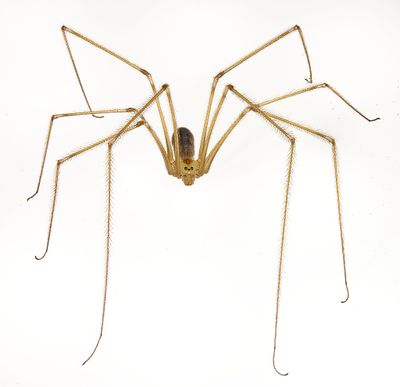Cool Critters: Being home alone is nearly impossible thanks to cellar spiders

Chances are, a creature with eight long, super-skinny legs lives inside your home.
Meet your housemate: the long-bodied cellar spider. Often mistaken for daddy longlegs because of their hair-like legs and wispy appearance, these secretive arachnids live exclusively in the great indoors.
Hanging out in dimly lit corners, under appliances and inside storage containers, you may be oblivious to the presence of these peaceful cohabitants. Nonetheless, “the ones in your home this winter are likely to be long-bodied cellar spiders,” entomologist Mike Bush of the Washington State Department of Agriculture in Yakima said. Considered beneficial because they eat bugs such as earwigs, flies and roaches, they are not aggressive or dangerous to humans, he added.
Even if you’ve never seen a cellar spider inside your tightly sealed home that you clean each day, probably at least a few live in your domestic interior, according to recent research.
In a large-scale census of indoor bugs conducted by North Carolina State University, researchers found cellar spiders “in every single house,” according to a university news release. Even houses that underwent pesticide treatments contained cellar spiders and dozens of other bug species.
The study, published in the journal Peer J in 2016, concluded that the long-bodied cellar spider was the most commonly found.
Another interesting finding? Homes in wealthier neighborhoods hosted a greater number of bugs, including cellar spiders. Scientists theorized this was due to larger house space, the presence of house plants and being closer to trees and parks.
OK, so now we know our homes provide a welcoming environment for cellar spiders to live out their lives. If we can’t feel enthused by the idea of sharing space with them, perhaps a little wonder will suffice.
“They are truly trapeze specialists,” said Bush, the bug-loving scientist.
“When disturbed, they hang and shake in their webs so rapidly that both the spider and the web blur to the point where they appear to disappear in thin air,” he explained.
Despite their leggy and delicate appearance, cellar spiders and daddy longlegs are not the same critter.
“They’re frequently lumped together,” although there are some big differences, Bush said.
Unlike cellar spiders, daddy longlegs live mostly outdoors and can be seen scuttling about in yards and gardens in the summer. In winter, they gather in groups under rocks, in tree cracks and wood piles, and sometimes they find their way into garages and sheds. After the weather warms, they return to the great outdoors.
Finally, daddy longlegs, also known as harvestmen, don’t build webs, which further sets them apart from cellar spiders. In fact, daddy longlegs aren’t even spiders, Bush said.
Wait – daddy longlegs aren’t spiders? Hmmm. Sounds like a good topic for a column in the spring when they begin crawling toward lawns and gardens. Until then, rest assured, the long-bodied cellar spider peering out from a dark corner of the house is the real deal.